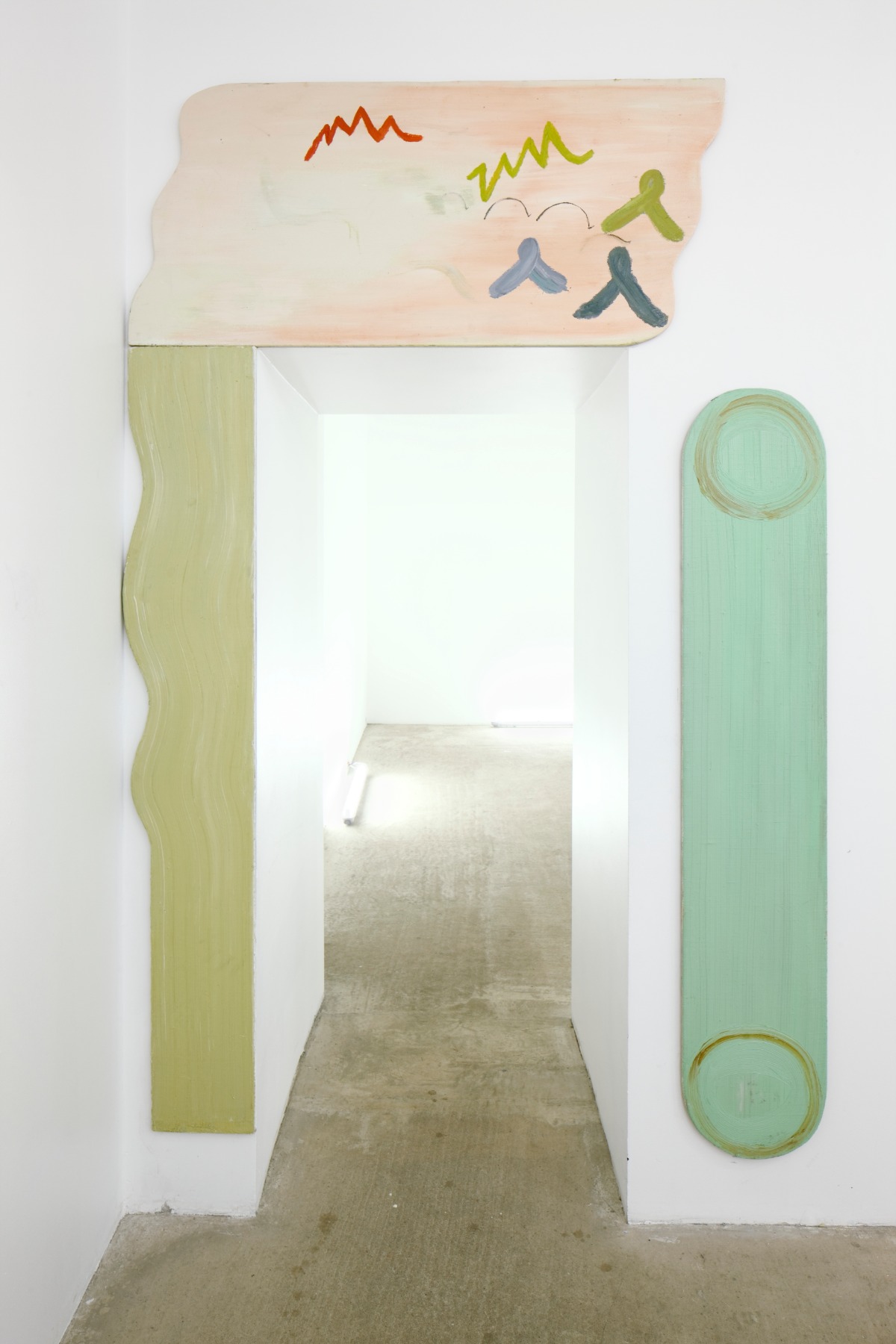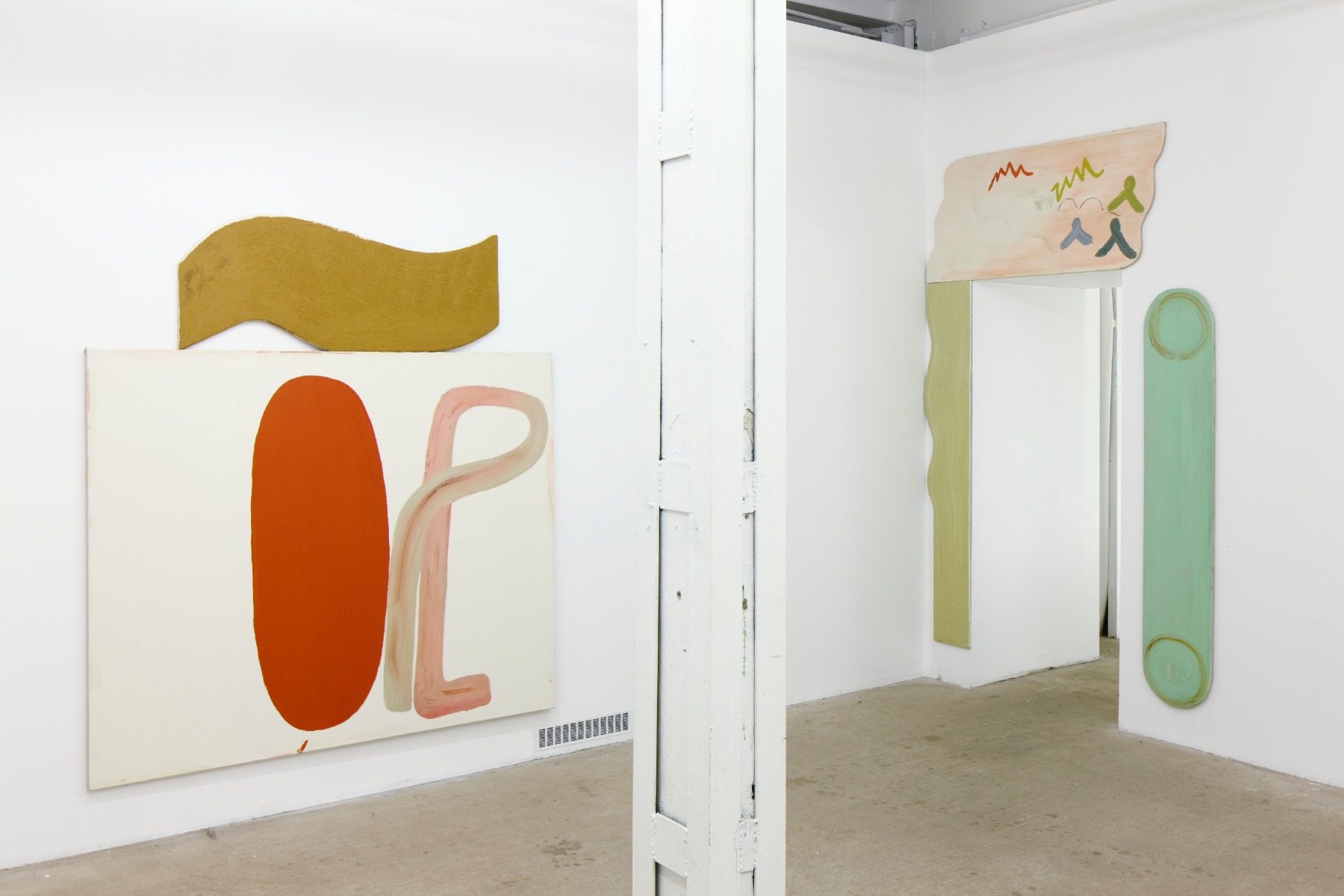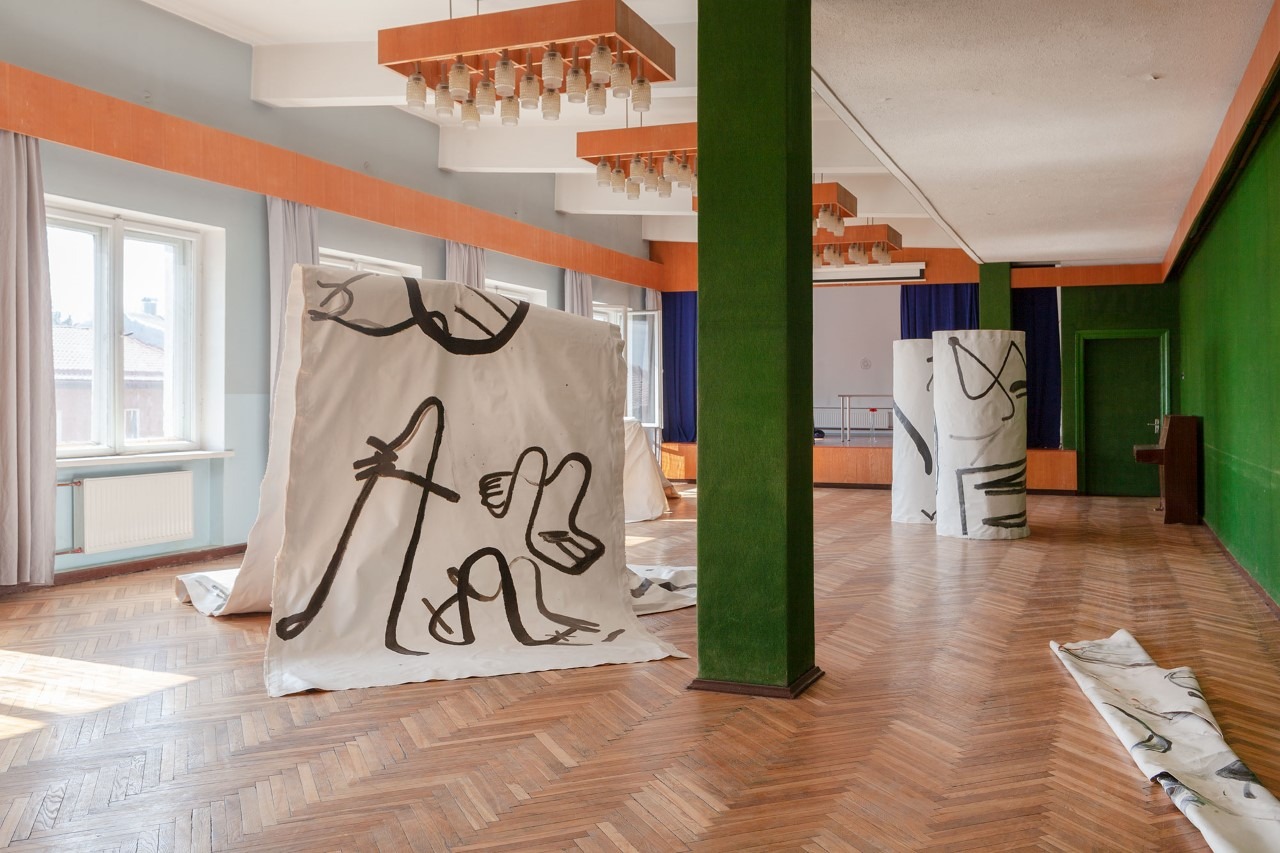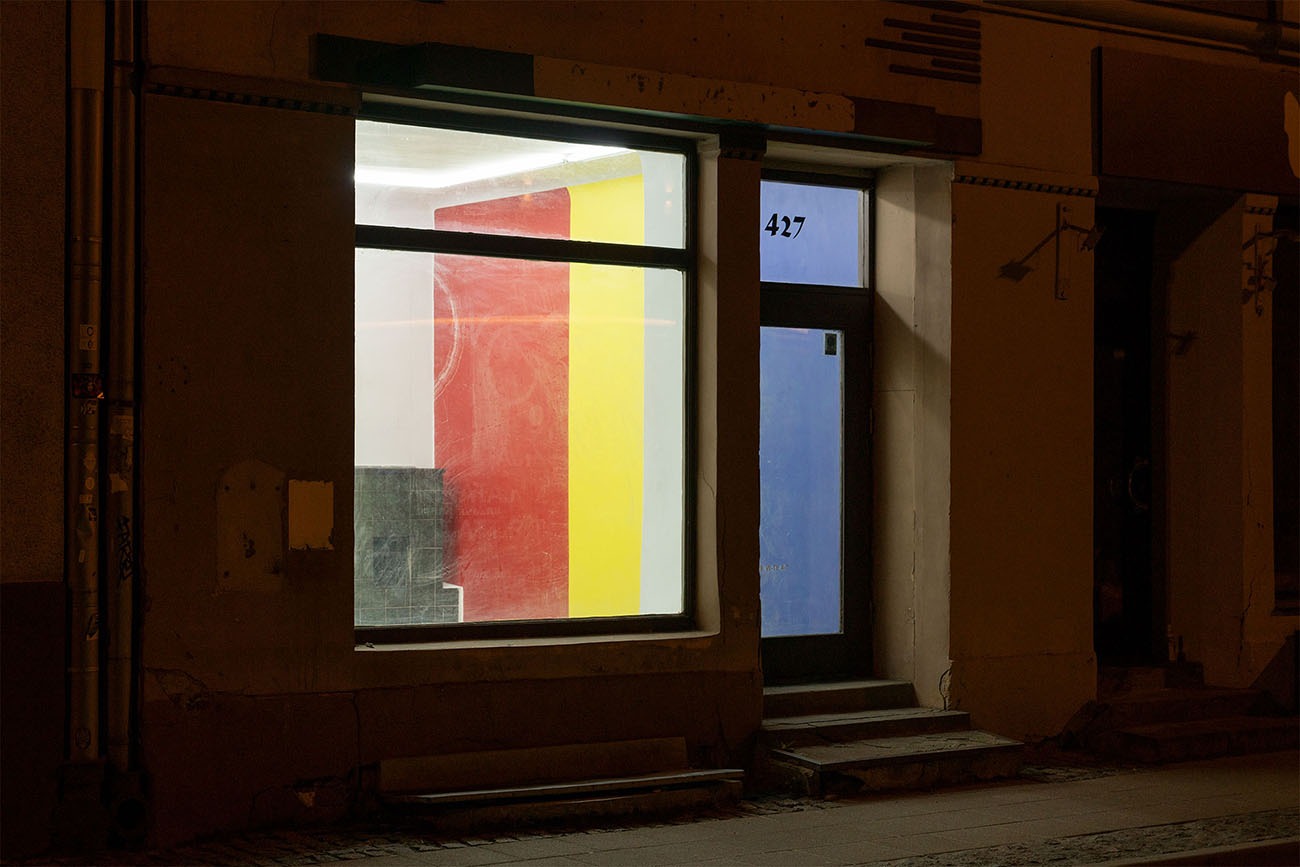
The Method: To Think With Paint
An interview with Amanda Ziemele
As one of the most extraordinary young artists in the Latvian contemporary art scene, Amanda Ziemele has made the final eight for the 2021 edition of Latvia’s most prestigious art award, the Purvītis Prize. She’s a painter who does not limit herself to the usual two-dimensional rectangular/square plane, but seeks to expand her space of expression beyond the conventional painting frame. Her works are arranged in a unique puzzle in which each piece of ‘pure’ paint is important for the whole, as is their mutual rhythm and their distance from each other. Her paintings can be found on the ceiling; just as well, some can be seen by crouching down to the level of the baseboards. Ziemele has admitted that she truly is interested in the accepted set of formal painting techniques – the materiality and tenderness of the paint, the dustiness of the pigments – all of which she ‘mixes together with her thoughts’. At the same time, she emphasises that her art is not detached from life; in fact, it is her commentary on events and the world. ‘I have asked myself what is the driving force that makes me go and resolve something every day. It would be so easy if we knew what this was. It is probably the desire to get involved, to comment, but the most important thing is the need to face difficulties, to plug along, and to offer one’s point of view.’
Your exhibitions always have paradoxical and intriguing titles – Fish With Legs, The Mind Is Like a Sponge, The Crocodile’s Dilemma. The one nominated for the Purvītis Prize 2021 is Quantum Hair Implants, which was held at the Kim? Contemporary Art Centre. To what extent is the narrative, the substantive message of the title, important to you?
It has not yet been the case that the title of the exhibition has served as a starting point from which I have created works. It should rather be seen as a key figure. The title is more of an indicator of what I am interested in during the process, and how the relationship between interests affects the course of my thoughts or the direction of my actions. It is possible to suddenly encounter a process that will further influence future choices. I am more apt to try and look for the form of the process, to materialise it. The beginnings of Quantum Hair Implants were largely based on the material itself. In mixing pigments and paints and creating the necessary consistency, I began to think about the rules of the quantum world and about the smallest particle that I encounter ‘face-to-face’ on a daily basis and what its role is in some larger process; I began to think about the loss of information, about how particle pairs and particle-anti-particle pairs communicate with each other and how we can pass on information to each other – how can we access it. And at the same time, it is also a question of the extent to which the viewer has access to the information that I have put into the works and that which I have hidden. The viewer often indicates a wish to know how the artist has arrived at the result, but at the same time they must be aware that even though it is not possible to access everything, it is possible to follow the course of thought. I am more likely to be giving out clues – the possibility of finding something or becoming lost. The motive of the game is important to me.
Quantum hair should be perceived as procedural objects – it is the procedurality that matters. Quantum Hair Implants is not an exhibition about science; it includes a set of questions that touch upon on a more multi-layered range of issues. It contains formal qualities, relationships, a paradox, and a joke about different situations.
Amanda Ziemele. Exhibiton "Quantum Hair Implants" at the Kim? Contemporary Art Centre. 2019. Photo: Ansis Starks
Is the process one of your tools?
Although at times it seems that, in the context of art, use of the word ‘process’ has become difficult to mention due to its frequent use, it is very important to me. It indicates a set of actions in motion. As for the different approaches, I can choose a new starting point each time – it can be conceptual, intuitive, or variable. The selection is influenced by the purpose. These are ideas that I can mix up with one another or transform.
What is it about painting that draws you to it? Why do you find it suitable and relevant for today’s world? There’s also a view that that it is a medium that has lost its vitality; still others openly associate it with the commercial side of art. At the same time, the physicality of painting and the artist’s direct contact with the work of art have once again become topical.
In answering, I’ll refer to my childhood experience, when I chose to portray what I was thinking about with pencils and gouache. It seems that back then I had already set the way I work with paint as a tool. The most important thing appears to be that since the age of five, I have been constantly trying to create something with materials. I just recently remembered how I used to make these small exhibitions at home – I created dioramas in the wardrobe from collected materials (objects, readymades, drawings and notes) on various themes that interested me. I didn’t make them just for myself – I invited my family to come see the exhibitions at a set time. These were one-day exhibitions that I did not record in any way. Later on, I enrolled at the Janis Rozentāls Riga Art High School because I wanted to be able to work in various fields of art in an unscheduled way in my daily life. At that time I was also exposed to different views and assumptions about painting, as well as with different points of view that have influenced the formation of my set of positions. I think that painting has a certain ambivalence. It has often been criticised for its ‘shortcomings’, and has been self-critical by pointing this out as well, but if we look at it, for example, throughout the 20th century, then painting, like other fields, has repeatedly commented on, supplemented, and expanded itself. If I think about why painting still seems important to me, then there are several reasons, one of which is direct contact with the material – the fact that I work with this messy paint that is involved in creating meanings as well as mixing them up.
Materiality?
Yes, exactly, materiality – the opportunity to formulate ideas in material, where they face difficulties in being defined without having to look for a direct translation or equivalent in the use of language. This is an important aspect of painting, and it doesn’t use just paint.
You have admitted that you are interested in form and formal techniques. In the context of contemporary art, form is often secondary.
Yes, I’ve been thinking about that – there is a belief that in contemporary art the idea is more important. But at the same time, the work of art does have a form. The relationship between the two is variable – it can develop in different directions. When I’m working on the plans for an artwork, I think and I look for a form of ideas and relationships. But I also need a material that is not text. If I could formulate the idea of the work through words alone, there would be no reason to paint it.
Amanda Ziemele. Exhibiton "Quantum Hair Implants" at the Kim? Contemporary Art Centre. 2019. Photo: Ansis Starks
Your painting often goes beyond the usual square or rectangular plane, appearing in a variety of shapes and taking on unusual forms.
This is important; it seems very important to me at times to free oneself of the plane in its traditional sense, and in the context of the history of painting, this is nothing uncommon. If, for example, I tried to convey the idea of an eyebrow in a picture, that would be something completely different than when the eyebrow is painted on an eyebrow-shaped plane (in reference to the work Raised Eyebrow – Ed.). That is one aspect, but it is equally important that I can assume that a given wall of the room is my plane. The interconnection of the planes is also significant. There are several levels that are important to me – the image, its form, and also the space within which the form operates. And also the mutual relationship between the forms, because by removing something from the set, a completely different relationship would form. The distance between the works and how close the viewer can get to them is also important. I usually exhibit my works quite low, which changes the usual sightline – that affects perception. I look for a suitable point of view. The means of expression are interconnected, just like the works are.
Amanda Ziemele. Exhibiton "Quantum Hair Implants" at the Kim? Contemporary Art Centre. 2019. Photo: Ansis Starks
Sometimes I also experience new discoveries in the exhibition space. That was the case with the work Singular In the Plural, which in the exhibition Quantum Hair Implants was placed high up and thereby became the ceiling. I hadn’t seen it from such a point of view before because I had painted it on the floor.
The fact that the contours of my works are not industrially made is a deliberate choice. When sawing out a particular shape, I’ll make manual mistakes; that way I’m cutting with deliberate inaccuracy, maybe even clumsiness. It think that paintings are also a bit imprecise – even their four corners are not at perfect angles.
Amanda Ziemele. Exhibiton "Quantum Hair Implants" at the Kim? Contemporary Art Centre. 2019. Photo: Ansis Starks
It could be said that your painting expands into space, creating a kind of puzzle in which each unit plays a role in creating a common story. It’s like a kind of game.
I recently started reading Georges Perec’s book Life: A User’s Manual, in which the first pages of the introduction are about the principles of a puzzle: it is first a whole – a single area – and only then does it become small pieces – fragments. Later on it also mentions what a standardised system of cutting up jigsaw puzzles can do to the image; that made me laugh. And I began to wonder if, in the context of my exhibitions, the individual works could be seen as the pieces of a puzzle. In that case, sometimes various different puzzles could be combined. And maybe they’ve been put together the wrong way so that when you try to insert the wrong piece, a part of it has to be shaved off to make it fit. But when I use the term ‘game’ in my work, this label gives me the opportunity to feel free. It allows me to talk about the history of painting, think about issues regarding painting, the problematics, and mix it all up in a sticky mixture. For me, art is a field in which to reflect upon all this.
What are these issues regarding painting – the problematics – that you contemplate?
I’m interested in issues related to the changing relationship of painting when thinking about expansions that spread in different contexts. Using various methods and strategies, I think about the relationship between painting and space, as well as the relationship between space and the image, the object, and their connection with the mechanisms of perception and experience.
Do you comment on life in your art?
Yes, certainly. It is difficult to not participate in processes that are interconnected, relevant and alongside us. My goal is definitely to continue the conversation, engaging in it with my own point of view. I have asked myself what is the driving force that makes me go and resolve something every day. It would be so easy if we knew what this was. It is probably the desire to get involved, to comment, but the most important thing is the need to face difficulties, to plug along, and to offer one’s point of view.
It is typical for me to think for a very long time, and then there comes a moment when I can formulate it precisely. I create these large piles of visual notes. I am not looking for a result; I’m trying to get my idea down in physical form. I often use the method of ‘thinking with paint’, leaving quite a lot of room for shifting things as they come to mind and transform. However, such a change can only take place if it is given the opportunity.
When it comes to art, you refer to modernism and the history of painting. To what extent has tradition influenced you, and how does it determine your decisions?
I view tradition as a material. At one time, modernism was characterised by a denial of previous generations’ ideas. I don’t find that engaging. I think it is important to take into account what has happened before so that things can be moved forward, though not necessarily in the direction of progress. It is clear that my experience and the specifics of the local environment have shaped my mindset, to say nothing of a lack of the abstract. When I first went to Italy at the age of eight, we visited Pompeii. That left a big impression on how I think about painting. As an example, it presents a set of questions related to several aspects of painting – a form of painting that was encapsulated underground and then dug up. It was a city where the contemporary art of that time coexisted in various ways – from everyday signs (what we today call graphic design) to the representative public and public spaces. In the context of Pompeii arises the question of the presence of time wearing things down, about the impermanence of art. Two years ago I decided to return to Pompeii; now it is more reminiscent of a set of fragments. For a number of reasons, they have not succeeded in preserving it.
Amanda Ziemele and Elīna Vītola at the work "Monumental Cafe" at the festival MABOCA or Madona Bunch of Cool Art. 2019
The impermanence of art was also the focus of the work Monumental Cafe, created by you and Elīna Vītola (as part of the 2019 festival MABOCA or Madona Bunch of Cool Art – Ed.). This impermanence was depicted there in the most direct way – by using edible works of art.
Yes, that can be seen as a commentary on the impermanence of a work of art and the presence of imagination, which then led us to the now-gone monumental cafes – to the interiors that were destroyed despite their importance. These were excellent testaments of the era as well as expressions of artist collaborations in which applied art interacted, for example, with painting. Often times only black and white photographs are all that we have left of them. Sometimes the available sources of information do not even indicate the location – apparently, at that time it was obvious where a particular cafe could be found. At the same time, it is a question of where can works of art be found? Where are they located? In thinking about my creative activity, I don’t feel a need to only be shown in a white cube. I find it interesting to think about other spaces and the contexts that they open up.
Amanda Ziemele, Elīna Vītola. "Monumental Cafe" at the festival MABOCA or Madona Bunch of Cool Art. 2019

Would you like your work to be a part of life rather than just exhibits in exhibition halls?
Sometimes, yes. Insofar as that when a work has been created in the context of a space, once the space changes, part of the work will disappear and become a fragment, but another variable will be gained.
Is this a wish to take art out of the ivory tower?
Obviously, art can be found outside of museums. When we executed the Sol LeWitt wall drawing at 427 Gallery last spring, the gallery was facing financial difficulties threatening its existence. And then we thought about it and laughed – it will soon be possible to rent a room in Riga with a Sol LeWitt wall drawing. In this context, the ability to adapt to and influence different spaces is important.
Amanda Ziemele and Elīna Vītola setting up the exhibition "Sol LeWitt's WD#179" at 427 Gallery. 2020
How did you and Elīna Vītola come up with the idea of doing a Sol LeWitt wall drawing?
Through talking about painting. We were thinking about it as an event, not just as an artistic gesture. Sol LeWitt’s realm of activity was very broad, but in the context of this series of works, he was referring to how art can adapt to different spaces and influence them – even spaces that are not institutions. In studying his work WD #719, we discovered that MASS MoCA was exhibiting Sol LeWitt: A Wall Drawing Retrospective at the time, with some 100 paintings, most of which had been ‘transferred’ to panels. This is, in essence, a bit contrary to LeWitt’s intentions. By participating in the creation of this work, it was as if we were inviting Sol LeWitt to Riga for a joint project. It was great experience in how his instructions can be followed, which at the same time leave room for a bit of interpretation – as LeWitt himself pointed out, the person executing the piece is an essential element in the process of its creation, thereby causing small changes to occur. It was also an opportunity to get closer to LeWitt’s thought process – to follow the course of his thoughts by viewing them through my and Elīna’s viewpoint. The work was being made as the first lockdown was coming into effect, but Elīna and I were able to continue drawing its outline. If we had been allowed to, we would have liked to have continued because if you’ve drawn two lines, it’s always possible to draw another one between them.
Do you tend to cite things, use hidden references?
It can definitely be sensed that I do in some way. I try to put these different mindsets and references together – sometimes in ways that, perhaps, they haven’t been before. It’s more like a continuation of the conversation with those involved in the issue at different times and places, given the different starting points of our views.
Amanda Ziemele, Elīna Vītola. Exhibition "Sol LeWitt's WD#179" at 427 Gallery. 2020
As you already mentioned, you tend to work closely with Elīna Vītola. Why do you need to be in synergy with someone else?
It think that for artists working alone and thinking about issues that interest them, it is very important to talk to someone else as well. And our tandem provides the opportunity to bring up issues that can come across stronger through us collaborating rather than just through our individual practices. Cooperation is an opportunity to expand our fields of activity by combining them. It all started with the aforementioned Monumental Cafe, which we were invited to create for Margrieta Griestiņa’s first MABOCA by taking over the local Consumer Association Hall. But most importantly, our joint projects change – we’re seeking new two-way roads and ‘carparks’.
Amanda Ziemele, Elīna Vītola. Exhibition "Sol LeWitt's WD#179" at 427 Gallery. 2020
In the case of the Sol LeWitt wall drawing, you both created one work. But it was more than a collaborative project.
Yes; in this collaborative format, the issue of the concept of authorship emerged – the fact that no one will be able to say exactly which drawn line was done by whom. And that it doesn’t even matter.